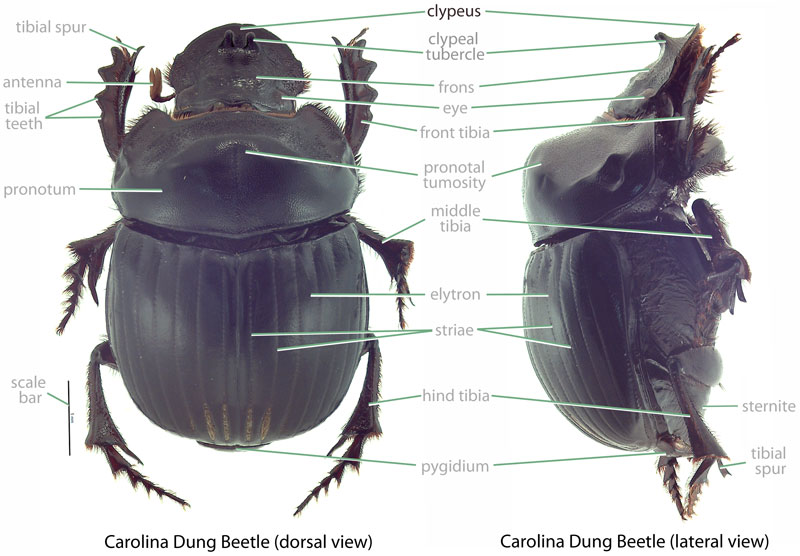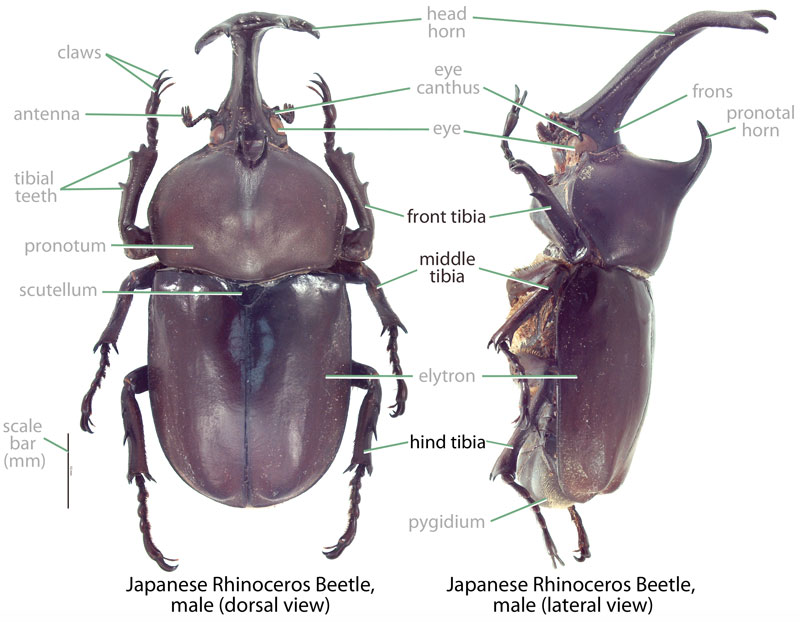Pest
Midway emerald beetle
Family: Scarabaeidae Subfamily: Cetoniinae Genus: Protaetia Species: Protaetia pryeri (Janson, 1888)
none available
Total body length 19.0–28.0 mm (0.75–1.1 in). Body broad oval; dorsoventrally flattened. Color shiny bright green, rarely shiny olive-green, lacking pale markings. Clypeusclypeus:
part of the head anterior to the frons; the most anterior portion in dorsal view
 broad, anterioranterior:
broad, anterioranterior:
the front or forward; opposite of posterior
margin entire to sinuatesinuate:
gently curved (specifically of margins or edges); often in reference to the clypeus
. Front tibiatibia:
a segment of the leg articulated with the tarsus and femur
 of male with 2 or 3 external teeth (third toothtooth:
of male with 2 or 3 external teeth (third toothtooth:
a pointed process from an appendage or margin, often in reference to the tibia
weak); female with 3 external teeth. Hind tibiatibia:
a segment of the leg articulated with the tarsus and femur
 with single lateral ridge. ElytraElytra:
with single lateral ridge. ElytraElytra:
the hardened and chitinous wing-cover of a beetle that protect and overlie the flight wing
lacking apical spine in both sexes.
Undescribed. For Cetoniinae (Ritcher, 1966Ritcher, 1966:
Ritcher P. 1966. White grubs and their allies: a study of North American scarabaeoid larvae. Oregon State University Monographs, Studies in Entomology 4: 1-219.): Like other Protaetia species, when alive, larvaelarvae:
the immature form of an insect; in scarabs, also called grub or white grub; preceded by the egg stage, followed by the pupal stage
 crawl on their backs with their legs up, and they feel distinctly "squishy" rather than firm (a characteristic of coconut rhinoceros beetle (Oryctes rhinoceros) larvae). Grub C-shaped, not hump-backed, cylindrical, whitish. Maxillamaxilla:
crawl on their backs with their legs up, and they feel distinctly "squishy" rather than firm (a characteristic of coconut rhinoceros beetle (Oryctes rhinoceros) larvae). Grub C-shaped, not hump-backed, cylindrical, whitish. Maxillamaxilla:
set of paired mouthparts located posterior to the mandibles
with galeagalea:
outer branch or lobe of the maxilla
 and lacinialacinia:
and lacinialacinia:
inner portion of the maxilla fused, or nearly so. Labrumlabrum:
fused, or nearly so. Labrumlabrum:
upper lip that covers the mandibles and is located ventrally relative to the clypeus
 symmetrical. Claws of hind legs large, cylindrical and hairy. 9th and 10th abdominal segments fused. Anal opening transversetransverse:
symmetrical. Claws of hind legs large, cylindrical and hairy. 9th and 10th abdominal segments fused. Anal opening transversetransverse:
extending horizontally across a surface
, straight to slightly curved.
Japan. In Japan this species is found on Okinawa and the Ryuku Islands (Arakaki, et al. 2009Arakaki, et al. 2009:
Arakaki N, Shimoji Y, Wakamura S. 2009. Camphor: an attractant for the cupreous polished chafer, Protaetia pryeri pryeri (Janson) (Coleoptera: Scarabaeidae). Applied Entomology Zoology 44: 621-625. full text (accessed: 2015)).
Adults of this species are associated with the overripe or damaged fruit of a number of plant species. These plants include papaya (Carica papaya), guava (Psidium guajava), and wax apple (Syzygium samarangense) (Arakaki, et al. 2009Arakaki, et al. 2009:
Arakaki N, Shimoji Y, Wakamura S. 2009. Camphor: an attractant for the cupreous polished chafer, Protaetia pryeri pryeri (Janson) (Coleoptera: Scarabaeidae). Applied Entomology Zoology 44: 621-625. full text (accessed: 2015)). While only a handful of plants have been formally described as hosts, it is likely that this beetle, like the related Protaetia orientalis, is a generalist frugivorefrugivore:
an organism that feeds primarily on fruit
capable of damaging a wide range of fruit species (Ijima and Takeuchi, 2007Ijima and Takeuchi, 2007:
Ijima K, Takeuchi M. 2007. Life history of Protaetia orientalis (Coleoptera: Scarabaeidae) in the Kanto District; and food resource plants of P. orientalis in Japan. Japanese Agricultural Science, Tokyo University of Agriculture 52: 89–96.). Protaetia pryeri is also known to visit flowers for nectar and pollen (Nishida and Beardsley, 2002Nishida and Beardsley, 2002:
Nishida G and Beardsley J. 2002. A review of the insects and related arthropods of Midway Atoll. Bishop Museum Occasional Papers 68: 25–69. full text (accessed 2015)) and may visit sap flows like Protaetia orientalis (Ijima and Takeuchi, 2007Ijima and Takeuchi, 2007:
Ijima K, Takeuchi M. 2007. Life history of Protaetia orientalis (Coleoptera: Scarabaeidae) in the Kanto District; and food resource plants of P. orientalis in Japan. Japanese Agricultural Science, Tokyo University of Agriculture 52: 89–96.). While it has been suggested that larvaelarvae:
the immature form of an insect; in scarabs, also called grub or white grub; preceded by the egg stage, followed by the pupal stage
 of this beetle may attack plant roots (Nishida and Beardsley, 2002Nishida and Beardsley, 2002:
of this beetle may attack plant roots (Nishida and Beardsley, 2002Nishida and Beardsley, 2002:
Nishida G and Beardsley J. 2002. A review of the insects and related arthropods of Midway Atoll. Bishop Museum Occasional Papers 68: 25–69. full text (accessed 2015)), this is not typical of cetoniine scarabs (Ritcher, 1966Ritcher, 1966:
Ritcher P. 1966. White grubs and their allies: a study of North American scarabaeoid larvae. Oregon State University Monographs, Studies in Entomology 4: 1-219.), and related species are known to subsist entirely on organic soil debris and compost (Gujarathi and Pejaver, 2014Gujarathi and Pejaver, 2014:
Gujarathi G and Pejaver M. 2014. Life cycle studies of Protaetia aurichalcea (Cetoniinae: Cetonidae: Scarabaeidae) in household biocompost. Species 10: 86-97. full text (accessed: 2015)).
On Midway Island, larvaelarvae:
the immature form of an insect; in scarabs, also called grub or white grub; preceded by the egg stage, followed by the pupal stage
 were found in organic-rich soils, particularly near ironwood (Casuarina species) or occasionally naupa-ka (Scaevola species) (Nishida and Beardsley, 2002Nishida and Beardsley, 2002:
were found in organic-rich soils, particularly near ironwood (Casuarina species) or occasionally naupa-ka (Scaevola species) (Nishida and Beardsley, 2002Nishida and Beardsley, 2002:
Nishida G and Beardsley J. 2002. A review of the insects and related arthropods of Midway Atoll. Bishop Museum Occasional Papers 68: 25–69. full text (accessed 2015)). Adults emerged beginning in April, with numbers declining until December.
Moderate. Like the Asian flower beetle (Protaetia orientalis), this species is often noticed in large feeding aggregations on fruit. While the sight of these aggregations may be alarming for plant owners, beetles rarely cause significant damage to healthy fruit (LeBlanc et al., 2013LeBlanc et al., 2013:
Leblanc L, Graham S, Pohlman K, Fujita B. 2013. Protaetia orientalis (Coleoptera: Scarabaeidae) attracted to methyl eugenol fruit fly lure. Proceedings of the Hawaiian Entomological Society 45: 45–48. full text (accessed 2015)). Instead, beetles prefer overripe or already damaged fruit, perhaps attracted to the odors of fermentation (LeBlanc et al., 2013LeBlanc et al., 2013:
Leblanc L, Graham S, Pohlman K, Fujita B. 2013. Protaetia orientalis (Coleoptera: Scarabaeidae) attracted to methyl eugenol fruit fly lure. Proceedings of the Hawaiian Entomological Society 45: 45–48. full text (accessed 2015)). Beetles are, however, capable of causing minor damage to surrounding healthy fruits or flowers with their sharp tarsal claws when they clamber towards target fruit (LeBlanc et al., 2013LeBlanc et al., 2013:
Leblanc L, Graham S, Pohlman K, Fujita B. 2013. Protaetia orientalis (Coleoptera: Scarabaeidae) attracted to methyl eugenol fruit fly lure. Proceedings of the Hawaiian Entomological Society 45: 45–48. full text (accessed 2015)).
Recorded, not established. Although not yet known from the main Hawaiian Islands, this species is established on Midway (Nishida and Beardsley, 2002Nishida and Beardsley, 2002:
Nishida G and Beardsley J. 2002. A review of the insects and related arthropods of Midway Atoll. Bishop Museum Occasional Papers 68: 25–69. full text (accessed 2015)), where it is sometimes abundant.
Established. This beetle was first recorded on Guam in 1990 and has since become one of the island's most conspicuous scarab species (Moore, 2010Moore, 2010:
Moore A. 2010. Invasive insects on Guam. Micronesia Biosecurity Plan Meeting, Guam 2010. Available from: http://aliens.guaminsects.net/sites/default/files/GuamInvasiveInsectsMBP20100120.pdf (accessed 2015).).
In Japan, this species has been found aboard marine vessels (National Institute for Environmental Studies, 2014National Institute for Environmental Studies, 2014:
Anonymous. 2014. Invasive species of Japan: Protaetia pryeri oschimana . National Institute for Environmental Studies. Available from http://www.nies.go.jp/biodiversity/invasive/DB/detail/60520e.html (accessed April 25 2015).). Further, because adults are attracted to fermenting fruits and nectar-bearing flowers, it is possible that Protaetia pryeri could hitchhike on nursery plants. Adults could also be accidentally spread in shipments of commercially grown fruits.
This beetle is one of the three species in the genus Protaetia known from Hawaii and Guam. The remaining two species are the Protaetia pryeri and Protaetia fusca. These three species are separated by size (P. orientalisat 19.9–26.8 mm [0.78–1.1 in] versus P. fuscaat 12.0–17.0 mm [0.47–0.67 in]), examination of the elytral apices (P. orientalis and P. pryeri always without apical spines versus P. fuscawith apical spines in the male), and hind tibiatibia:
a segment of the leg articulated with the tarsus and femur
 (P. orientalis with 2 lateral ridges versus P. fuscaand P. pryeri with a single lateral ridge).
(P. orientalis with 2 lateral ridges versus P. fuscaand P. pryeri with a single lateral ridge).
Cetonia pryeri Janson, Protaetia nitidicosta Yawata, Protaetia okinavana Miksic, Pyropotosia pryeri Reitter
Report your observation of this species at our iNaturalist project.